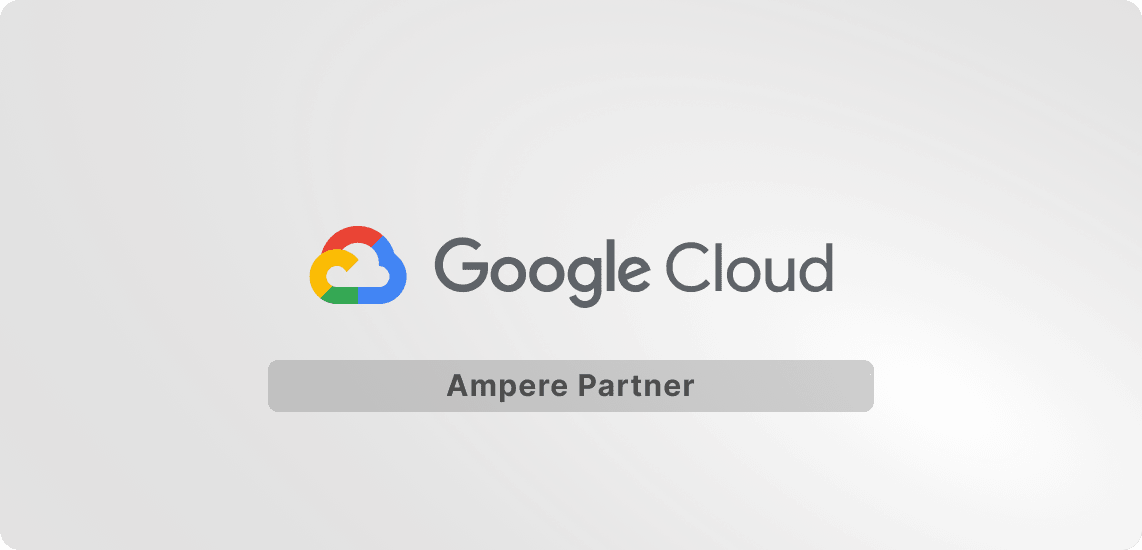
Google Cloud
Google Cloud’s Compute Engine Tau T2A VMs are powered by Ampere® Altra® processors, T2A VMs deliver exceptional single-threaded performance at a compelling price. T2A VMs come in multiple predefined VM shapes, with up to 48 vCPUs per VM, and 4GB of memory per vCPU. They offer up to 32 Gbps networking bandwidth and a wide range of network attached storage options, making T2A VMs ideal for scale-out workloads including web servers, containerized microservices, data-logging processing, media transcoding, and large-scale Java applications.
Google Cloud customers and developers can now have the option of choosing an Ampere Cloud Native Processor to test, develop and run their workloads on the optimal architecture for their workload.
Integration with the Google Cloud Ecosystem
T2A VMs support most popular Linux operating systems such as RHEL, CentOS, Ubuntu, and Rocky Linux. In addition, T2A VMs also support Container-Optimized OS to bring up Docker containers quickly, efficiently and securely. Further, developers building applications on Google Cloud can already use several Google Cloud services with T2A VMs.
-
Google Kubernetes Engine - Google Kubernetes Engine (GKE) is the leading platform for organizations looking for advanced container orchestration, delivering the highest levels of reliability, security, and scalability. GKE supports T2A nodes, helping you get the most out of your containerized workloads. You can add nodes based on T2A to your GKE clusters by choosing the T2A machine type in your GKE node pools.
-
Batch – Google Cloud’s newly launched Batch service supports T2A. As of today users will be able to run batch jobs on T2A instances to optimize their cost of running workloads.
-
Dataflow - Dataflow is a fully managed streaming analytics service that minimizes latency, processing time, and cost through autoscaling and batch processing. You can now use T2A VMs with your Dataflow workloads.
ISV Partner and Ecosystem
Ampere lists more than 100 applications, databases, cloud native software and programming languages that are already running on Ampere based T2A VMs. Further, independent software vendor (ISV) partners that have validated their solutions on T2A VMs have been impressed by the ease with which they were able to port their software to Tau T2A VMs.
Pricing and Availability
T2A VMs are price-performance optimized for your cloud-native applications. Click here to see current prices.
T2A VMs are currently in several Google Cloud regions: us-central (Iowa -), europe-west4 (Netherlands) and asia-southeast1 (Singapore C), Us-east1 (South Carolina) and us-west1 (Oregon).
To learn more about T2A VMs or other Compute Engine VM options, check out our machine types and pricing pages. To get started, go to the Google Cloud Console and select T2A for your VMs.
Performance Spotlight
Performance Spotlight

SPEC CPU®2017 Integer Rate
SPEC CPU®2017 Integer Rate
The Standard Performance Evaluation Corporation (SPEC) is a non-profit corporation formed to establish, maintain and endorse standardized benchmarks and tools to evaluate performance and energy efficiency for the newest generation of computing systems. SPEC develops benchmark suites and also reviews and publishes submitted results from our member organizations and other benchmark licensees.
NGINX on Google VMs based on Ampere
NGINX on Google VMs based on Ampere
NGINX is a high-performance HTTP web server that is widely used for cloud web applications. As a web server, the performance of NGINX depends on compute, memory, and network performance making it a great test subject for the overall performance of our processors.

x264 on Google VMs based on Ampere
x264 on Google VMs based on Ampere
The x.264 library, which implements the H.264/MPEG-4 AVC standard is very widely used today in a variety of video streaming services, runs extremely well on Ampere processors at scale.
Cassandra on Google VMs based on Ampere
Cassandra on Google VMs based on Ampere
Apache Cassandra is a free and open-source, distributed, wide column store, NoSQL database management system designed to handle large amounts of data across clusters. Due to its resilience and failure tolerance, Cassandra is used in many digital service infrastructures across the industry and runs very well on Ampere's Cloud-Native processors.
Virtual Machine Configurations
Virtual Machine Configurations
T2A
Powered by Ampere Altra processors, T2A VMs deliver exceptional single-threaded performance at a compelling price. T2A VMs come in multiple predefined VM shapes, with up to 48 vCPUs per VM, and 4GB of memory per vCPU. They offer up to 32 Gbps networking bandwidth and a wide range of network attached storage options, making T2A VMs ideal for scale-out workloads
| VM TYPES | VCPUS (PHYSICAL CORES) | MEMORY (GB) | MAXIMUM EGRESS BANDWIDTH (GBPS) |
|---|---|---|---|
| T2A-standard-1 | 1 | 4 | 10 |
| T2A-standard-2 | 2 | 8 | 10 |
| T2A-standard-4 | 4 | 16 | 10 |
| T2A-standard-8 | 8 | 32 | 16 |
| T2A-standard-16 | 16 | 64 | 32 |
| T2A-standard-32 | 32 | 128 | 32 |
| T2A-standard-48 | 48 | 192 | 32 |
Resources
Resources
Blogs & Announcements
Customer Stories
Watch Video
Briefs
Tutorials

